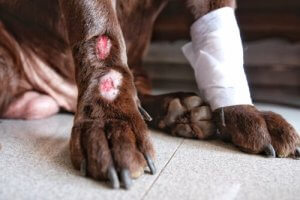Canine Health: Symptoms of Tetanus in Dogs

Once or twice, you might have found yourself wondering whether dogs can suffer from tetanus. Unfortunately, yes they can. But in that case, why don’t we vaccinate our pets against it? The answer is that, although dogs can contract tetanus, they are naturally more resistant to it than many other animals.
As a result, cases of canine tetanus are fairly rare. While cats are also highly resistant to tetanus, humans and horses are extremely susceptible.
Causes of tetanus in dogs
This illness is caused by an infection of Clostridium tetani bacteria, which usually enter the body through deep cuts. It’s important to be aware that C. tetani are naturally present in some soils.
Despite what many people think, C. tetani don’t usually live in rusted metal; rather, they live in dirt on the rusted metal. This is useful information to keep in mind. In fact, it’s best to be careful with all sharp objects, whether they are rusty or not.
It’s dirt from the soil that poses the real danger. Many people are unaware that it is not the bacteria itself that causes the illness. Tetanus is caused by the neurotoxin tetanospasmin.
The bacteria enter the organism through a cut or wound. After a few days of incubation, the bacterial spores start to produce a toxin. The toxin binds with the nervous system, and the typical tetanus symptoms start to develop.
Another interesting fact is that any C. tetani bacteria that the animal ingests, or that come into contact with the skin, do not cause any problems. This is because the bacteria require an oxygen-deprived environment in order to produce the toxin.

Clinical signs of tetanus
Symptoms of tetanus typically start to appear between 5 and 10 days after the initial wound is inflicted. However, in some cases, symptoms can appear earlier, or up to 3 weeks after exposure.
The toxin affects the nerves, the spinal cord and the brain, which leads to nerve hyperexcitability, causing muscle spasms. In dogs, tetanus can take two distinct forms.
1. Localized tetanus
This is the most common form of tetanus in dogs. The affected animals develop muscle stiffness in their extremities, or in the muscles closest to the wound.
As well as muscle stiffness, you may also notice muscle spasms. Localized tetanus can progress to generalized tetanus if left untreated, although this isn’t always the case.
2. Generalized tetanus
Generalized tetanus affects extensive areas of the body. Affected animals walk stiffly, with their tails raised bolt upright or extended straight behind them.
Their muscles can become so stiff that they can no longer bend their joints to stand up. Many develop what is known as “sawhorse stance”, with all four legs held out rigidly.
Generalized tetanus often affects the muscles in the face. Many animals develop elevated third eyelids, wrinkled foreheads (due to muscle spasms) and the lips seem to freeze in a rictus grin.
The jaws often lock shut, which is why tetanus is commonly known as lockjaw. The animal will no longer be able to swallow, leading to difficulty eating and excessive drooling.
In some cases, tetanus can also cause muscle spasms in the throat or diaphragm – the muscle that controls respiration – making it difficult for them to breathe.

Many animals with generalized tetanus will also develop a fever. This fever isn’t usually due to the bacterial infection itself. Instead, it is caused by the heat generated by the constant muscle contractions.
Treatment of tetanus in dogs
Treatment of tetanus mainly consists of supportive care. Vets will continue treatment while the dog’s nervous system recovers from the damage caused by the neurotoxin.
Dogs with generalized tetanus are unable to walk. As a result, they require intensive nursing. A veterinary nurse will give them soft bedding, and will help them change position frequently to prevent ulcers and bedsores. In some cases, they may need to feed the dog through a nasogastric feeding tube. They may also need a catheter to help empty their bladder.
Furthermore, it’s best to keep external stimulation to a minimum. Keeping the animal in a calm, dark environment helps to reduce stimulation, which can worsen muscle spasms. Recovery may take weeks or even months, but with the right treatment, many dogs survive.

There’s no vaccine for canine tetanus
If your dog cuts itself on barbed wire or another sharp object, you should immediately be on high alert. You’ll probably ask yourself, “Now what? Won’t my dog need a tetanus shot?”
Unfortunately, there’s no vaccine for canine tetanus. There are several FDA approved tetanus vaccinations for humans, horses and sheep, but there’s no vaccination for dogs.
Because tetanus is relatively rare in dogs, sales of a tetanus vaccine probably wouldn’t cover the cost of its development. As a result, it’s hardly surprising that no pharmaceutical company has yet invested in one.
Regardless of any economic factors, there are also a number of ethical considerations to take into account. To determine whether a vaccine would be effective in dogs, investigators would first have to infect dogs with the bacteria.
The infection and the resulting illness, the treatment and the possible side effects of the vaccination would cause the animal great suffering, and some animals would undoubtedly die in the course of the investigation. All in all, it seems unlikely that a vaccine will ever be developed.
Prevention of tetanus in dogs
If there’s no vaccination available against canine tetanus, how else can you protect your pet?
First, make sure to clean any cuts carefully and thoroughly. Bites and deep wounds pose the greatest risk when it comes to developing tetanus. Don’t hesitate to consult a vet if your pet sustains this type of injury.
If your pet has an open wound, be sure to keep a close eye on it for a few weeks. If you notice any signs of stiffness around the site of the wound, seek veterinary attention immediately. Early diagnosis and treatment can greatly improve prognosis.
Once or twice, you might have found yourself wondering whether dogs can suffer from tetanus. Unfortunately, yes they can. But in that case, why don’t we vaccinate our pets against it? The answer is that, although dogs can contract tetanus, they are naturally more resistant to it than many other animals.
As a result, cases of canine tetanus are fairly rare. While cats are also highly resistant to tetanus, humans and horses are extremely susceptible.
Causes of tetanus in dogs
This illness is caused by an infection of Clostridium tetani bacteria, which usually enter the body through deep cuts. It’s important to be aware that C. tetani are naturally present in some soils.
Despite what many people think, C. tetani don’t usually live in rusted metal; rather, they live in dirt on the rusted metal. This is useful information to keep in mind. In fact, it’s best to be careful with all sharp objects, whether they are rusty or not.
It’s dirt from the soil that poses the real danger. Many people are unaware that it is not the bacteria itself that causes the illness. Tetanus is caused by the neurotoxin tetanospasmin.
The bacteria enter the organism through a cut or wound. After a few days of incubation, the bacterial spores start to produce a toxin. The toxin binds with the nervous system, and the typical tetanus symptoms start to develop.
Another interesting fact is that any C. tetani bacteria that the animal ingests, or that come into contact with the skin, do not cause any problems. This is because the bacteria require an oxygen-deprived environment in order to produce the toxin.

Clinical signs of tetanus
Symptoms of tetanus typically start to appear between 5 and 10 days after the initial wound is inflicted. However, in some cases, symptoms can appear earlier, or up to 3 weeks after exposure.
The toxin affects the nerves, the spinal cord and the brain, which leads to nerve hyperexcitability, causing muscle spasms. In dogs, tetanus can take two distinct forms.
1. Localized tetanus
This is the most common form of tetanus in dogs. The affected animals develop muscle stiffness in their extremities, or in the muscles closest to the wound.
As well as muscle stiffness, you may also notice muscle spasms. Localized tetanus can progress to generalized tetanus if left untreated, although this isn’t always the case.
2. Generalized tetanus
Generalized tetanus affects extensive areas of the body. Affected animals walk stiffly, with their tails raised bolt upright or extended straight behind them.
Their muscles can become so stiff that they can no longer bend their joints to stand up. Many develop what is known as “sawhorse stance”, with all four legs held out rigidly.
Generalized tetanus often affects the muscles in the face. Many animals develop elevated third eyelids, wrinkled foreheads (due to muscle spasms) and the lips seem to freeze in a rictus grin.
The jaws often lock shut, which is why tetanus is commonly known as lockjaw. The animal will no longer be able to swallow, leading to difficulty eating and excessive drooling.
In some cases, tetanus can also cause muscle spasms in the throat or diaphragm – the muscle that controls respiration – making it difficult for them to breathe.

Many animals with generalized tetanus will also develop a fever. This fever isn’t usually due to the bacterial infection itself. Instead, it is caused by the heat generated by the constant muscle contractions.
Treatment of tetanus in dogs
Treatment of tetanus mainly consists of supportive care. Vets will continue treatment while the dog’s nervous system recovers from the damage caused by the neurotoxin.
Dogs with generalized tetanus are unable to walk. As a result, they require intensive nursing. A veterinary nurse will give them soft bedding, and will help them change position frequently to prevent ulcers and bedsores. In some cases, they may need to feed the dog through a nasogastric feeding tube. They may also need a catheter to help empty their bladder.
Furthermore, it’s best to keep external stimulation to a minimum. Keeping the animal in a calm, dark environment helps to reduce stimulation, which can worsen muscle spasms. Recovery may take weeks or even months, but with the right treatment, many dogs survive.

There’s no vaccine for canine tetanus
If your dog cuts itself on barbed wire or another sharp object, you should immediately be on high alert. You’ll probably ask yourself, “Now what? Won’t my dog need a tetanus shot?”
Unfortunately, there’s no vaccine for canine tetanus. There are several FDA approved tetanus vaccinations for humans, horses and sheep, but there’s no vaccination for dogs.
Because tetanus is relatively rare in dogs, sales of a tetanus vaccine probably wouldn’t cover the cost of its development. As a result, it’s hardly surprising that no pharmaceutical company has yet invested in one.
Regardless of any economic factors, there are also a number of ethical considerations to take into account. To determine whether a vaccine would be effective in dogs, investigators would first have to infect dogs with the bacteria.
The infection and the resulting illness, the treatment and the possible side effects of the vaccination would cause the animal great suffering, and some animals would undoubtedly die in the course of the investigation. All in all, it seems unlikely that a vaccine will ever be developed.
Prevention of tetanus in dogs
If there’s no vaccination available against canine tetanus, how else can you protect your pet?
First, make sure to clean any cuts carefully and thoroughly. Bites and deep wounds pose the greatest risk when it comes to developing tetanus. Don’t hesitate to consult a vet if your pet sustains this type of injury.
If your pet has an open wound, be sure to keep a close eye on it for a few weeks. If you notice any signs of stiffness around the site of the wound, seek veterinary attention immediately. Early diagnosis and treatment can greatly improve prognosis.
All cited sources were thoroughly reviewed by our team to ensure their quality, reliability, currency, and validity. The bibliography of this article was considered reliable and of academic or scientific accuracy.
- Liu-Wu, Y. C., & Orozco-Cárdenas, A. (2014). Tratamiento de las mordeduras de perro. Revista medica de costa rica y Centroamérica, 71(610), 289-292.
- Hernández, C. M. (2009). Tétanos en un perro: caso clínico. REDVET. Revista Electrónica de Veterinaria, 10(4), 1-4.
- Font i Pla, X. (1992). Tétanos en el perro. Clínica veterinaria de pequeños animales, 12(3), 0181-190.
- Sánchez, M. (2018). Presentación de un caso de tétanos en un canino. (Tesis de especialidad, Universidad Católica de Córdoba).
This text is provided for informational purposes only and does not replace consultation with a professional. If in doubt, consult your specialist.








